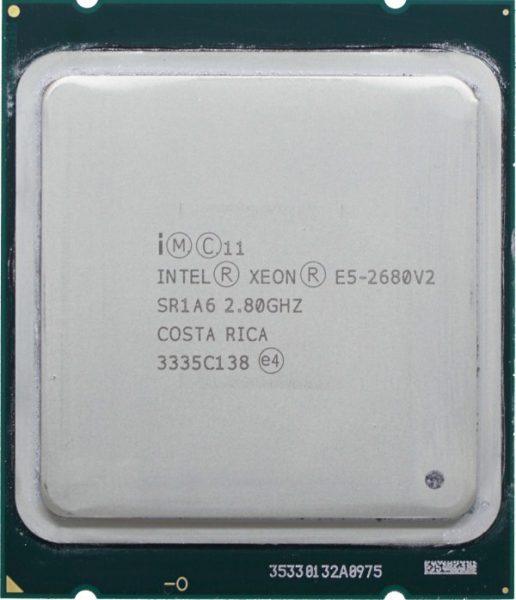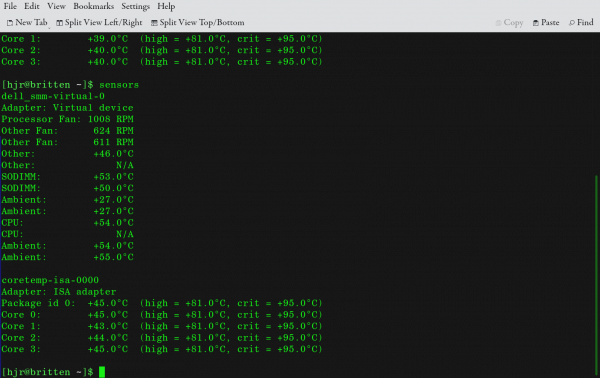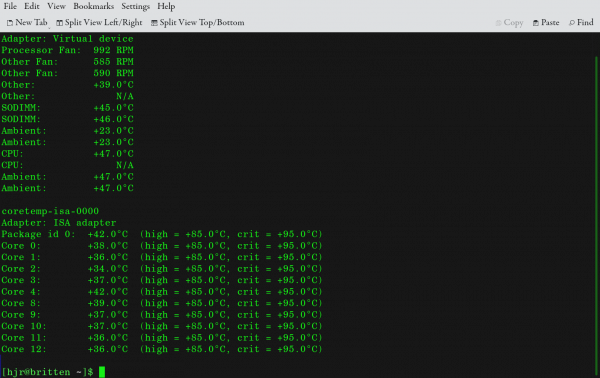 Fresh from my war with a new mini PC (which I lost, you'll recall), I remained determined to do something to upgrade my old workstation-class desktop PC. I bought it second-hand a few years ago: it's a Dell Precision T3610, which is a bit of a monster, and was originally constructed (I think) in around 2012 or 2013: its warranty says it started in February 2014 and expired in February 2017, so it's somewhere in that ball-park.
Fresh from my war with a new mini PC (which I lost, you'll recall), I remained determined to do something to upgrade my old workstation-class desktop PC. I bought it second-hand a few years ago: it's a Dell Precision T3610, which is a bit of a monster, and was originally constructed (I think) in around 2012 or 2013: its warranty says it started in February 2014 and expired in February 2017, so it's somewhere in that ball-park.
It shipped with a Xeon E5-1620 v2 CPU CPU, which was launched in the third quarter of 2013, so that also helps date the machine. That CPU has (inevitably, as far as Intel was concerned back then!) 4 cores and thus 8 threads when hyperthreading was enabled. Nothing too remarkable, but not exactly shabby, either. I think when I bought it, it came with 16GB of RAM: I soon bumped that up to 96GB. So, it's not memory constrained either! It also shipped with an Nvidia Quadro K4000, which was cutting edge at the time, but has long since been eclipsed by newer graphics cards: since I don't play games beyond Solitaire, however, I don't particularly care how out-of-date my graphics capabilities are!
Anyway: I'm already RAM'd up to the hilt; I have no need for better graphics: how else could I possibly upgrade or improve this PC? Well, I figured a CPU upgrade might be on the cards!
£60 on Ebay netted me a Xeon E5-2680 v2 CPU. It's not a 100% guaranteed upgrade for the 1650, but I saw suggestions that 98% of upgrades worked fine -which, to my mind, meant they probably all did, except for the one where an incompetent user was involved! Perhaps a little oddly, the new CPU runs at a lower clock-speed than the original 1620: 2.8GHz base versus 3.7GHz... that's a fairly hefty downgrade, right? True: but, the new CPU can turbo to 3.6GHz, which is a much smaller decrement on the original (which could only turbo up to 3.9GHz). Moreover, the new CPU has 25MB of L3 cache versus the 1620's 10MB: I figured the extra cache would probably make up for the slower clock-speeds. The other (real) reason for the choice of this CPU, though, was that it comes with a whopping 10 cores, meaning 20 threads with hyperthreading enabled. That's two-and-a-half times more worker threads than the original CPU ever had available to it: I imagined that, even if they were clocked slower than on the original CPU, the fact that there was more of them might make things seem to be running more quickly and smoothly. Only time would tell, I guess...
Anyway: I bought it, so had to fit the darn thing... and I hate doing CPU replacements!!
To make my chances of success perhaps a little better, I decided to check if there was a BIOS update available for my machine from the Dell website. I wasn't exactly expecting there to be, given the thing's approaching 10 years old... but, sure enough, there was an A19 release, dated 2019, considerably newer than my A17 release. It comes in the form of an .exe which you are then supposed to launch using Windows... which is a bit of a drama for anyone using Linux, like me! Fortunately, there's also a no-operating-system-at-all upgrade option, whereby you merely boot to the BIOS setup menu and then take the 'BIOS Flash Update' whilst a USB drive with the .exe sitting on it is read. There are, inevitably, dire warnings about not switching off in the middle of the BIOS update... which is thus always a nerve-wracking time. Not so much because I'd turn it off, but I can never be sure that the electricity supply won't be interrupted by road workers slicing through a cable somewhere!
Fortunately, the BIOS update went without a hitch and I was able to boot into my Manjaro desktop using my old CPU for the last time afterwards.
So now it was time to crack open the PC case and get down and dirty with the hardware side of things: literally dirty in this case, because there was so much dust inside the CPU heat sink!
Getting the heatsink off was easy, however: four Phillips screws. A portable, hand-held vacuum was brought in to get rid of as much dust (and a few cobwebs, I think!) as I could reasonably manage. After that, I cleaned off the old thermal paste from both the heat sink base and the old CPU: it was very dry and crusty, like crumbling chalk: some wiping with tissues and cloths soaked in isopropyl alcohol got rid of that mess (remind me not to light candles any time soon, though: I was a bit liberal with the application of the alcohol!). Releasing the two CPU clasps was fairly easy, and the old CPU itself was then simple to remove. With the new CPU inserted in its place, it was time to do the scary business of applying new thermal paste!
It's scary because there are umpteen different ways you can apply it; the risks of applying too little are that your CPU will overheat and your PC will be unstable as a result; the risk of applying too much is that it oozes out everywhere and, possibly, shorts traces on the motherboard (or, if not actually shorts them, at least adds extra electrical capacitance to the motherboard in ways that could affect its behaviour). So, all in all, quite a lot to get wrong!
Well, I've done a few CPU replacements in my time (I've acquired quite a collection of old Celerons and Xeons, I can tell you!) and so I stuck with the 'one blob the size of a pea in the middle of the heat-spreader' technique. That pretty much always means no leakage of excess paste, but you end up relying on the heat sink to squoosh the stuff all over the heat spreader.
Then it was time to reboot... either the thing would reboot successfully, or not: it's a pretty binary situation!
And the good news for me, at least, is that it rebooted fine at the first time of asking! I rather excitedly opened up the System Monitoring tool that KDE provides:
I've literally never had to have the program display set so wide before! But there they all are: all 20 threads, laid out in a neat row 🙂
Was my thermal application paste done correctly, though? There's really only one way to check. Here are the CPU sensor readings for the original 1620 CPU, taken at the end of a day running quite a lot of music splitting and combining and tagging operations:
There are various ways of interpreting that, but it looks as if the original CPU was running at somewhere between 43° and 54° Celsius. And here's the new CPU readings, taken about an hour after inserting it and doing some more music playing, tagging and processing:
Now, that looks like somewhere between 36° and 47° Celsius: which is an improvement on the old figures and is probably mostly down to the new paste being fresh and paste-y, rather than dried and chalk-y. But at least it suggests that I didn't apply it badly!
To really check things out, though, I installed stress (on Manjaro, that's sudo pacman -S stress) and ran it like so:
stress --cpu 20 --timeout 300
That spawns 20 threads of work which run for 300 seconds before stopping. They have this effect on the CPU graph:
You can see all 20 threads work flat-out at 100%, and the graph flat-lines at the top of its range as soon as the test starts! This has an immediate effect on the CPU load reported by a tool such as 'uptime':
[hjr@britten ~]$ uptime 10:20:18 up 1:06, 5 users, load average: 18.04, 7.31, 3.4
...that 18.04 reading for the last 1 minute shows that the CPU is, indeed, pretty much working at its maximum capacity. As I type, I can hear that the CPU fan has cranked up the volume a bit (but nothing too objectionable). A re-reading of the temperature senors about 4 minutes into the test shows:
So, clearly the temperatures have increased: from ~40° to nearer 60° Celsius -but that remains well within this CPU's permitted maximum temperature of 82° Celsius. This PC has no need for elaborate cooling, I think!
Anyway, that about wraps things up: this PC is as kitted out to-the-max as I can probably get it. Short of buying a new Threadripper or Epyc system entirely, I am probably not going to have such a capable machine again in my lifetime! The dabble with mini-PC was an aberration, really: this PC runs quietly, capably and does all that I need it to do. With 20 threads at its disposal now, it can even unpack SACD ISOs about three times faster than before, so I have nothing to complain about... which, for me, is an unusual and happy state of affairs to be in!




